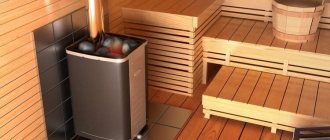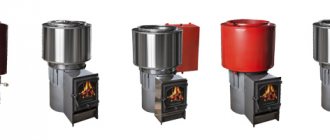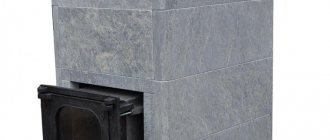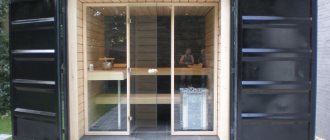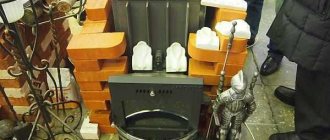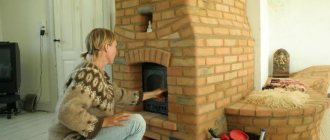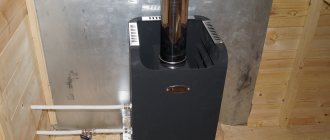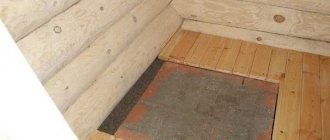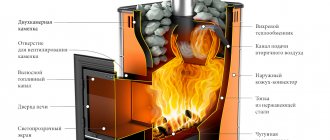Advantages of cast iron
A stove made from a cast iron bath will last almost forever. Even enamel will not burn out quickly. In Soviet times, enamel was applied in two layers. The enamel contained quartz sand. After coating with enamel, the product was baked in an oven at a temperature of more than 800 degrees. The sand melted, and this coating served for decades. The enamel could only be damaged by a strong blow from a heavy object.
Cast iron bathtub is durable enough to make a stove out of it
In addition, cast iron has a high heat capacity, accumulates and releases heat well. Not afraid of corrosion. The industry produces fireboxes and grates from cast iron, since it does not burn out for a long time, unlike steel. But cast iron is a rather brittle metal.
Stage No. 1: preparation of tools and materials
As for transporting the bathtub to the dacha, the most difficult thing was to bring it to the trailer. Cast iron is incredibly heavy and has the magical property of gaining mass with every step you take. But somehow, my comrades and I, nevertheless, put the “hippopotamus” into a prepared vehicle and I delivered it to the site of further work.
Only after everyone had suffered as loaders did the brilliant idea come to me that it was necessary to saw the font in the bathroom, because this would still need to be done in the future to create a stove. But two halves are much more convenient and easier to carry than the entire cast iron product.
It is better to cut the bath in advance in the apartment
Cutting the bathtub
It is best to saw the bathtub outdoors, after turning it upside down. Cast iron is a brittle metal, so the procedure requires care. The cutting is done with a grinder. Buy several cutting discs at once. We make markings, and then lightly cut the enamel along the line so that when a full cut is made, chips do not form. We saw through the cast iron at a slight angle and make sure that the tool does not heat up. We take breaks. To prevent the halves of the sawn tub from pinching the disk at the final stage of cutting, place supports made of wood or brick along the edges of the cut.
Bathroom cutting is done with a grinder
Preparatory stage
To make a stove from an old bathtub, you will need the following materials:
- the bath itself;
- Red brick;
- cement, sand, clay;
- crushed stone;
- steel sheet with a thickness of at least 4 mm;
- lattice or perforation;
- finished door with frame and hinges for the firebox;
- steel pipe for chimney;
- boards for formwork;
- roofing felt or polyethylene for waterproofing.
The cast iron bath for the stove needs to be cut in half.
Tools needed to complete the work:
- shovel, trowel, spatula;
- metalworking tools;
- electric drill with drills;
- grinder with high-quality cutting discs;
- measuring and marking tools;
- mounting gun for working with sealant;
- welding machine.
In preparation for work, it will be necessary to transport the old bathtub to the place where the stove is manufactured. Considering its large weight and the need to cut it in half, it would be more correct to make the cut before transportation.
Correct cut
The material of the font, which is to be sawed in half, is very fragile. Therefore, we must take this stage of work very responsibly:
- Turn the bathtub upside down and secure it in a stable position.
- Mark the cutting line taking into account the width of the cutting tool.
- Slowly, strictly according to the markings, make an incision along the entire line. This will destroy the protective layer of enamel, and when cutting, it will protect the cut end of the cast-iron font from chipping.
- Carefully, slowly, taking pauses for the tool and the cast iron being processed to cool, we will cut the bath in half. When carrying out such work, it is important to remember safety measures: use safety glasses and a respirator or gauze bandage.
It is advisable to install such a heavy building on a monolithic foundation
Furnace foundation
The type of foundation depends on the total weight of the furnace:
- A brick base is suitable for a light stove. The bricks are laid on edge and bonded with mortar. Cement grade for binder mortar is not less than M300;
- for a heavy furnace weighing more than 700 kg, a self-leveling foundation with a depth of at least 50 cm will be required. Formwork is made and filled with liquid concrete with or without filler. The filler will be fine broken brick or crushed stone.
The stove can only be built on a strong and heat-resistant base.
The top of the base is placed flush with the floor or 15 cm below the floor level. To protect the base from moisture, the bottom and walls of the formwork are covered with roofing material and all joints are coated with bitumen.
Advice. The base should protrude 50 cm beyond the boundaries of the stove. In front of the combustion chamber, 1.2 m of space should remain free.
Alternative modifications
In fact, these are not even modifications, but, on the contrary, somewhat stripped-down options, which, nevertheless, can also be very useful in the household. Moreover, both of them can be realized from one vessel:
- For example, how to make a bath with a cast iron grill stove? After all, fried meat cooked over an open fire is simply amazing. For this it will be enough:
- Take the half of the bathtub that does not have a drain hole and attach another pair of legs to the cut edge for structural stability;
- Place a suitable sized grill on top. It is not at all necessary to fix it “tightly”; on the contrary, the removable version is more convenient to use and maintain;
- That’s it, through the open façade you add firewood or remove coals, put pork, lamb or chicken on top, and heat-intensive cast iron helps create the temperature necessary for frying;
- You can also make an effective stove for a bathhouse from a cast iron container:
- Lay the bathtub upside down so that its main part is in the steam room on a pre-prepared concrete base, and the cut goes into the next room;
- Inside, install a grate with the help of corners, and cover the facade with a metal sheet equipped with doors for the firebox and ash pan;
- Install a chimney pipe with exit outside the bathhouse area. You can first weld a small horizontal pipe into the facade, and then use an elbow to bring the chimney vertically to the roof;
- In the steam room, build a brick wall around a cast iron container at a distance of 10 cm and as high as the tank itself;
The process of installing a stove-stove from an old cast-iron font
- Fill the gap between the bricks and the bathtub with stones, which, when heated, will provide the necessary heat.
Furnace No. 1
This version of the stove is capable of heating a bathhouse of 7 square meters. m to 80 degrees in just a couple of hours. To build a stove you will need scrap metal: a cast iron bath, a gas cylinder and a metal drum from a conveyor belt with a diameter of 40 cm. The drum can be replaced with a gas cylinder or pipe - this will be the combustion chamber. The sequence of work is as follows:
- A concrete foundation is being poured for the future furnace.
- The end of the bathtub is cut off.
- We make a combustion chamber: holes are drilled at the bottom of the drum. A box is welded to cover the holes and serve as an ash pit.
- We put the door on the firebox. You can use this spare part from an old stove.
- A gas cylinder is welded vertically at the opposite end of the drum.
- Now the resulting structure is placed in the bath.
Brickwork around the bathtub - A chimney pipe is welded to the cylinder.
- Lay the foundation with bricks to the height of the bathtub. Clay mortar is used for binding.
- After the masonry has dried, it is decorated with ceramic tiles. Tile adhesive is selected that is heat-resistant.
- Stones with a fraction of 7 to 15 cm are poured into the bathtub. Granite or pink quartzite. The stones quickly gain temperature and give off heat for a long time. Quartzite releases chemical compounds into the air that normalize blood pressure and metabolism. This bathtub can hold approximately 350 kg of stones. Bathhouse technologists claim that this number of stones is enough for a bathhouse of 10 square meters. m.
Advice. If you weld a flat metal platform to the cylinder, you will get a stove for heating the kettle.
Stage No. 2: cutting the cast iron font
I would like to warn you right away that this process is very labor-intensive, requiring great patience and caution, since during its implementation you can break the instrument and tear the disc, as a result of which there is a high probability of serious injuries to people nearby.
Schematic instructions for sawing a cast iron bathtub
- To begin with, I laid the bathtub on the ground upside down for ease of further operations;
- Strictly in the middle I drew a straight line with a marker, marking the place of the cut;
The cutting line should be strictly in the middle
- Next, strictly following the applied markings, using a grinder, I carefully made a cut into the enamel layer, the depth of which, as a rule, ranges from 1.5 to 2.5 mm. If you immediately start sawing the cast iron itself, then chips will form on the enamel covering it;
Scheme of cutting the enamel layer
- Now I moved on to sawing the font itself and did it slowly, regularly giving the tool rest. Believe me, the price of haste here can be very high; the saved 20-30 minutes will not replace your burnt angle grinder.
We invite you to familiarize yourself with Face masks for the bath: a product after the sauna for the skin Russian bath from Avon, scrub-mask Clean Line Phytobath, reviews
Furnace No. 2
From a cast iron bath sawn into two parts you can make a combustion chamber for a sauna stove. You will need one half, the second can be used for the fireplace.
- We are laying out the foundation.
- We install half of the bathtub with the dome up. The cut edge is inserted into the wall from where the firebox will be produced. The rest of the bath remains in the steam room.
The process of building a stove from half a cast iron bath - We fill the hole with a brick wall, into which we build the doors of the combustion chamber and the blower.
- Now we build a brick wall around the perimeter of the bathtub, flush with the bathtub. The distance from the bathroom to the wall is taken from 8 to 15 cm.
- We fill the space between the cast iron container and the brick wall with stones after the brickwork has completely dried. The stones will heat up and give off heat.
The remaining half can be used to build a fireplace. Cast iron can easily withstand brickwork if you line the fireplace with an arched vault. Moreover, for this you do not need to make a complex template from plywood. The front part is decorated with a portal. The chimney is removed. You can make the fireplace closed by installing a transparent door on the firebox and admire the flames.
Advice. Cast iron and red ceramic bricks have different coefficients of thermal expansion. Therefore, when constructing brick walls, expansion joints are provided, which are filled with asbestos or fire-resistant basalt cardboard.
Conclusion
Despite the fact that cast iron bathtubs of the last century are considered obsolete, a number of their qualities - durability, resistance to rust and stress, heat retention and strength - can be used to obtain objects with unique properties. The result of converting a used font into various ovens, a pond, a greenhouse, a flower bed or country furniture will become a source of pride and envy for your neighbors.
There is nothing difficult about creating your own stove from a cast iron bathtub. Follow the instructions carefully to get fantastic results. Rest assured that the quality of the stove will not be inferior to industrial models, but the cost will be orders of magnitude lower than that of the original!
Furnace No. 3
The third version of the stove is often used as a garden barbecue and for cooking in the summer. If the upper chamber is filled with stones, then such a design will replace a traditional stove in a small bathhouse, so we will not ignore this model.
- The foundation for the furnace is being poured.
- The bathtub is sawn into two identical components.
- Supports are placed on the foundation if you want the stove to be higher.
- The first half of the bath is installed. A sheet of metal with a thickness of at least 5 mm is laid on top, which will completely cover the upper and lower compartments and serve as a hob.
Construction of a barbecue stove from a cast iron bath - We cut the chimney pipe into the sheet and weld it along the contour.
- We install the second half on top with the bottom up, having previously cut a hole for the chimney.
- We glue the metal sheet and the halves of the cast iron device with high-temperature sealant. This will prevent smoke from entering the upper chamber.
- We clamp both parts with clamps and drill holes along the contour for 10 mm bolts. We fasten both parts of the bathtub and the metal sheet.
- We lay a brick pedestal under a three-wall oven.
- The grate is installed 15 cm from the bottom of the combustion chamber. If the grate size is small, then two corners are welded to install it.
- The front part is covered with a sheet of metal or brickwork with a door installed opposite the combustion and ash chambers.
Finished product from cast iron bathtub and sheet metal - A metal shutter is made according to the size of the upper chamber. In this form, the chamber can be used as an oven.
- Now all that remains is to give the product a noble appearance: cover the brick with tiles or plaster.
Such non-standard designs are easy to manufacture and require minimal financial costs. An item that has served its purpose will get a second life, and you will receive a convenient and practical stove that will serve you faithfully for many years.
Preparing a cast iron bathtub body for remodeling
The first stage of building a heater, regardless of its design and size, always begins with removing layers of old paint, limescale, rust, and all the debris that has accumulated on its surface over decades of use.
Some craftsmen recommend burning the body on wood in the open air. The stove is placed on bricks and a small fire is lit. It will take a long time to heat the cast iron bowl, at least 2-3 hours, until the remaining contaminants burn out. In this way, it is possible to get rid of ingrained odors and at the same time “reveal” the surface from layers of lime and rust.
